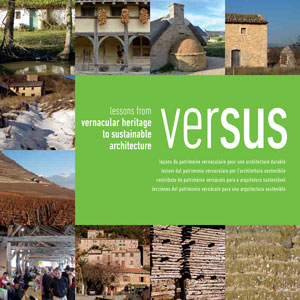
Research Method
Through literature review, it was possible to determine and to clarify the state of the art. The lack of articulation of different scientific areas on the subject, and the evolution of the Sustainable concept itself (Correia, 2009), constituted the critical difficulty in the groundwork of the operative methodological proposal.
To have a conceptual definition to advance on each area was a fundamental criterion to address a consistent and rigorous operative approach. When crossing the information with the partner’s experiences, and with the identified revision of the literature regarding the subject, it was decided to create a three-component structure that concerned Environment, Society and Economy. This selection was based on the overview of the main existing evaluation systems for building sustainability (Hegger et al., 2007). Thus, the identified scopes were:
- Environment: It concerned the capacity of the human intervention on decreasing and avoiding building’s adverse environmental impacts, reacting to every change in the environment, considered as the set of conditions, in which life is possible, and regarding the whole biological quality (Neila-González, 2004). It is widely interconnected with the economy scope specially attaining the aspects regarding energy consumption and building life cycles.
- Society: This scope related with relations, sense of belonging, identity, personal and community development. This scope gathered all the Social and Cultural positive impacts observable on the Vernacular solutions (Oliver, 2006). The emerged findings were more related to the processes than to the physic reality itself.
- Economy: It constituted the most quantitative scope of the sustainable sphere, conventionally adopting financial monetary values as basic indicators. Due to the Vernacular conceptual implications, the idea of cost was adapted to the concept of effort, which was more suitable, when applied to circumstances with no capital system implemented (Zupančič, 2009). This concerned the construction process, the building performance, the building maintenance, the building impact, and also the contribution to the improvement of local living conditions (Correia et al., 2014a).
Therefore, the methodology for the identification and analysis of the vernacular heritage was established, based on three main levels of conception: environment, society and economy. General Objectives, Needs related to each sustainable scope were established, as well as Principles and Strategies learnt from vernacular heritage for the design of a more sustainable architecture.
The established methodological proposal was understood as a conceptual framework, to be adapted and tested according to different geographical/ cultural contexts. This provided an operational knowledge to integrated in the contemporary architectural design process. The research project clearly approached the concept of sustainability from a transversal, holistic and multidisciplinary perspective (Correia et al., 2014a).
References
Correia, M., 2009. Sustentabilidade: Conceito e Desenvolvimento. In Energias Renováveis. Porto: Atelier Pã, p.68–76.
Correia, M., Carlos, G., Merten, J., Viana, D. & Rocha, S., 2014a. VerSus: Vernacular heritage contribution to sustainable architecture. In Correia, Carlos & Rocha (eds) 2014. Vernacular Heritage and Earthen Architecture. Contributions for Sustainable Development. London: CRC/ Balkema/ Taylor & Francis Group, p.833–838
Hegger, M., Fuchs, M., Stark, T. & Zeumer, M., 2007. Energy Manual - Energie Atlas. Sustainable Architecture. Birkhäuser Verlag. Basel/Berlin: Edition Detail
Neila-González, F. J., 2004, Arquitectura bioclimática en un entorno sostenible. Madrid: Editorial Munilla-Lería.
Oliver, P., 2006. Built to meet needs: cultural issues in vernacular architecture. Oxford: Elsevier.
Zupančič, D., 2009. Economy and common sense. Vernacular architecture simple solutions from past for today and Beyond. Mediterra 2009, 1st Mediterranean Conference on Earth Architecture, Conference proceedings. Monfalcone: edicom edizioni, p.537–549.



